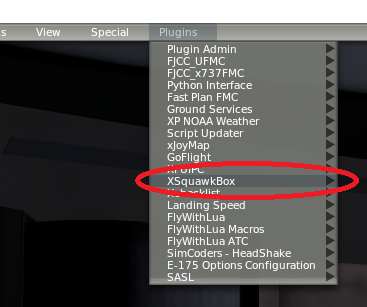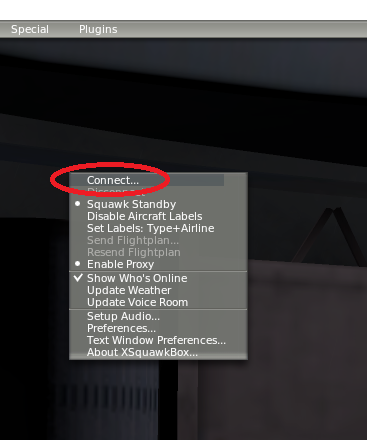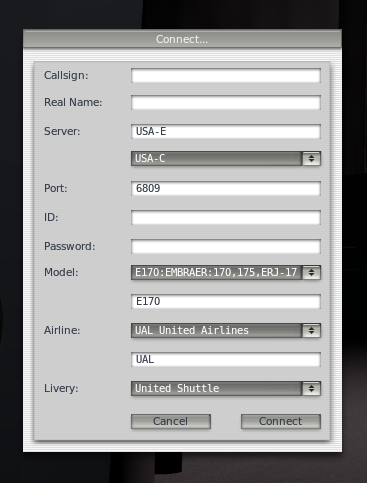
BVA's Getting Started Guide: Getting Connected
At this point, you are connecting to the "live" session. However, you don't necessarily have to start flying immediately. Members are welcome to connect to listen and observe initially. Of course, we'd love for you to start flying as soon as you feel ready.
This page uses screenshots from the XSquawkbox pilot client. However, the instructions and process are similar with the other two clients.
When your plane is at a gate or ramp, select "Plugins" from the menu and then XSquawkbox -> Connect:


Once finished, a box should pop up that looks like this:

Enter the following items:
* These are used for model matching on others screens. They may not work cross-platform and are not required to be accurate to use VATSIM.
Callsigns
When selecting a callsign, there are two choices.
If you plan to fly a General Aviation airplane (non-commercial), your aircraft is likely to use the tail number as the call sign.
Registration numbers (also called "N-number" or "tail number") for aircraft registered in the U.S. begin with the letter "N", which is followed by:
Note that the letters "I" (India) and "O" (Oscar) are not used in these tail numbers to avoid confusion with the numbers 1 (one) and 0 (zero), and the numeric portion of these callsigns cannot begin with zero (for example, N032BC is incorrect). Tail numbers for aircraft registered in other countries are quite different, and consist of five letters. Every aircraft registered in a particular country has the same prefix, which is assigned to that country. For example, an aircraft registered in Canada has a tail number that starts with either C-F or C-G, such as C-GYAP. While the "dash" in the tail number is written on the fuselage for readability, it is not included in air traffic systems. When filing a flight plan or choosing a callsign, the "dash" is omitted, and the tail number should be submitted as CGYAP instead of C-GYAP.
There are also specific 'formulas' for aircraft registrations from other countries. Some of these include LQ-xxx (Argentina), XB-xxx (Mexico) and HB-Vxx (Switzerland) - in all cases, the final three 'x' digits are to be replaced with numbers.
Airline callsigns consist of a three letter prefix assigned to the airline, followed by one to four numbers representing the flight number. Again, dashes are not used in the callsign (e.g., use AAL603 instead of AAL-603). A list of common callsigns can be found on the Airline Codes page of our website.
Model
When you connect, you also specify your model, or aircraft type. The model tells other pilots the aircraft you are flying. Each aircraft has a type code, which is normally three or four characters. A list of common type codes is available on the Type Abbreviations page of our website.
| Are you now connected to the network? |
| No, I wasn't able to get connected |